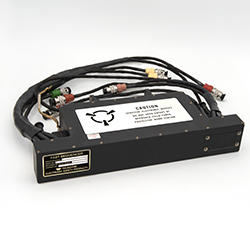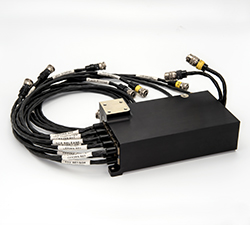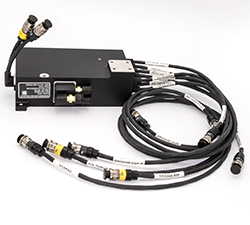
NACES Sequencer
 The Teledyne Electronic Safety Products (TESP) Navy Aircrew Common Ejection Seat (NACES) sequencer was designed and developed specifically for the Mk14 ejection seat to provide a significant improved recovery envelope through accurate mode selection and precise timing of events. It is fully supported by an O/I Level Tester (TTU-515/E) that permits full functional verification testing while the sequencer remains mounted on the ejection seat.
The Teledyne Electronic Safety Products (TESP) Navy Aircrew Common Ejection Seat (NACES) sequencer was designed and developed specifically for the Mk14 ejection seat to provide a significant improved recovery envelope through accurate mode selection and precise timing of events. It is fully supported by an O/I Level Tester (TTU-515/E) that permits full functional verification testing while the sequencer remains mounted on the ejection seat.
The TESP NACES Sequencer features the capability to process data from multiple sources such as on board sensors or external inputs. Programmable logic generates the decisions to fire redundant MIL-STD-1515 initiators according to the algorithm that is embedded. The original NACES unit is fully qualified and completed a 6000 hour reliability development test. Production deliveries commenced in August 1989 with 1373 delivered to support USN/USMC/FMS F-14D, F/A18A/B/C/D, and T-45A/C. Although originally specified for a 6 year service life, the biannual test via the TTU-515/E has allowed this design to remain in the field for over 25 years.
FAST Upgrade
 In 1998 the NACES Sequencer design was updated to eliminate component obsolescence. The resultant design was called the Future Advanced Sequencer Technology (FAST). The FAST upgrade includes expanded environmental sensing capability utilizing 21 sensors, extensive event recording during an ejection, continuous environmental sensing and a dynamic mode. The FAST sequencer utilizes modern COTS surface mount components enabling significantly improved performance and capabilities. This new FAST sequencer incorporates advanced processors with over 12 MB of program memory and 6 MB of event recording while retaining all the fail-op/fail-safe features of the original NACES Sequencer design. The FAST sequencer is fully supported by the existing O/I Level Tester TTU-515/E. To date over 1700 units have been delivered to USN/USMC/FMS users.
In 1998 the NACES Sequencer design was updated to eliminate component obsolescence. The resultant design was called the Future Advanced Sequencer Technology (FAST). The FAST upgrade includes expanded environmental sensing capability utilizing 21 sensors, extensive event recording during an ejection, continuous environmental sensing and a dynamic mode. The FAST sequencer utilizes modern COTS surface mount components enabling significantly improved performance and capabilities. This new FAST sequencer incorporates advanced processors with over 12 MB of program memory and 6 MB of event recording while retaining all the fail-op/fail-safe features of the original NACES Sequencer design. The FAST sequencer is fully supported by the existing O/I Level Tester TTU-515/E. To date over 1700 units have been delivered to USN/USMC/FMS users.
Joint Strike Fighter
 The Joint Strike Fighter (JSF) Sequencer is a subsequent version of the NACES FAST Sequencer. The unit is a physically repackaged set of electronics that has been missionized to perform the JSF Ejection Seat recovery function via firmware changes. This configuration removes the sensors that measure ram air via a pitot system and relies on a set of redundant 3 axis accelerometers to determine air speed. This in combination to continuous sensing makes the JSF Sequencer the latest advancement in aircrew safety. To date over 450 units have been delivered to USN/USAF/USMC/FMS users.
The Joint Strike Fighter (JSF) Sequencer is a subsequent version of the NACES FAST Sequencer. The unit is a physically repackaged set of electronics that has been missionized to perform the JSF Ejection Seat recovery function via firmware changes. This configuration removes the sensors that measure ram air via a pitot system and relies on a set of redundant 3 axis accelerometers to determine air speed. This in combination to continuous sensing makes the JSF Sequencer the latest advancement in aircrew safety. To date over 450 units have been delivered to USN/USAF/USMC/FMS users.
Digital Recovery Sequencer
 The Digital Recovery Sequencer (DRS) was developed as a replacement for the Analog Recovery Sequencer used on the ACES II Ejection Seat for USAF/FMS F15, F16, F22, F117, A10, B1B, B2 aircraft. It features a modern set of fail-safe/fail-op electronics unaffected by single point failures. The COTS electronics are programmable and expandable for a variety of applications and recovery sequence improvements. It also includes a solid state 3-axis accelerometer for incident recording and post ejection analysis. The Power Module is removable for periodic time changes leaving the electronics module installed in the seat. An external connector is available for field testing using the DRS Test Set which will perform a complete functional test of the unit to ensure continued mission readiness. The DRS uses the existing environmental sensor from the Analog sequencer and will perform one of 3 preprogrammed recovery modes. Since introduction in 2005, over 7500 units have been delivered to USAF/FMS users.
The Digital Recovery Sequencer (DRS) was developed as a replacement for the Analog Recovery Sequencer used on the ACES II Ejection Seat for USAF/FMS F15, F16, F22, F117, A10, B1B, B2 aircraft. It features a modern set of fail-safe/fail-op electronics unaffected by single point failures. The COTS electronics are programmable and expandable for a variety of applications and recovery sequence improvements. It also includes a solid state 3-axis accelerometer for incident recording and post ejection analysis. The Power Module is removable for periodic time changes leaving the electronics module installed in the seat. An external connector is available for field testing using the DRS Test Set which will perform a complete functional test of the unit to ensure continued mission readiness. The DRS uses the existing environmental sensor from the Analog sequencer and will perform one of 3 preprogrammed recovery modes. Since introduction in 2005, over 7500 units have been delivered to USAF/FMS users.
Modernized ACES Seat Sequencer
 The Modernized ACES Seat Sequencer (MASS) was qualified in 2014 to replace the DRS Sequencer. The MASS Sequencer eliminates all obsolete components from the DRS design while adding performance via on board sensing that replaces the mechanical environmental sensor. Expanded event recording allows better post ejection evaluation to include pressure and acceleration data from system initiation to seat impact. The MASS Sequencer is supported in the field by the DRS Test Set with the addition of a new interface cable. Since 2014, over 1000 units have been delivered to USAF/FMS users.
The Modernized ACES Seat Sequencer (MASS) was qualified in 2014 to replace the DRS Sequencer. The MASS Sequencer eliminates all obsolete components from the DRS design while adding performance via on board sensing that replaces the mechanical environmental sensor. Expanded event recording allows better post ejection evaluation to include pressure and acceleration data from system initiation to seat impact. The MASS Sequencer is supported in the field by the DRS Test Set with the addition of a new interface cable. Since 2014, over 1000 units have been delivered to USAF/FMS users.
